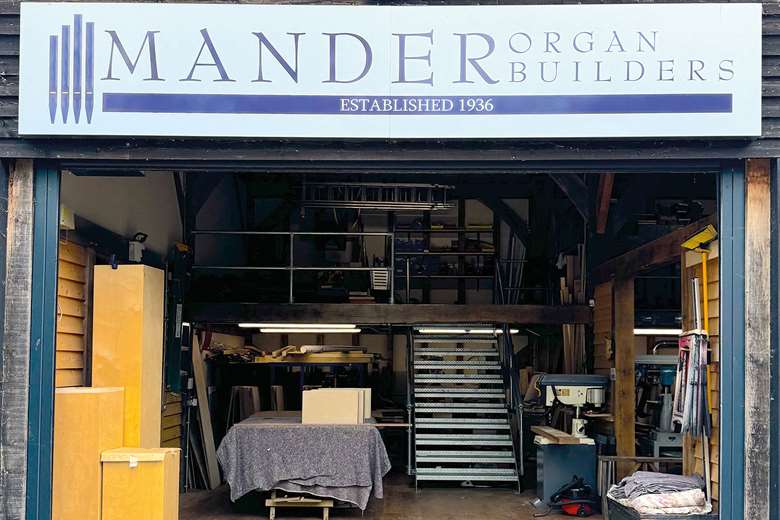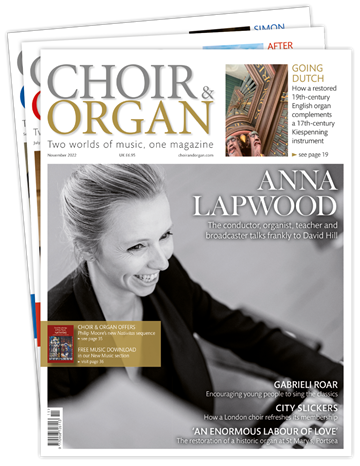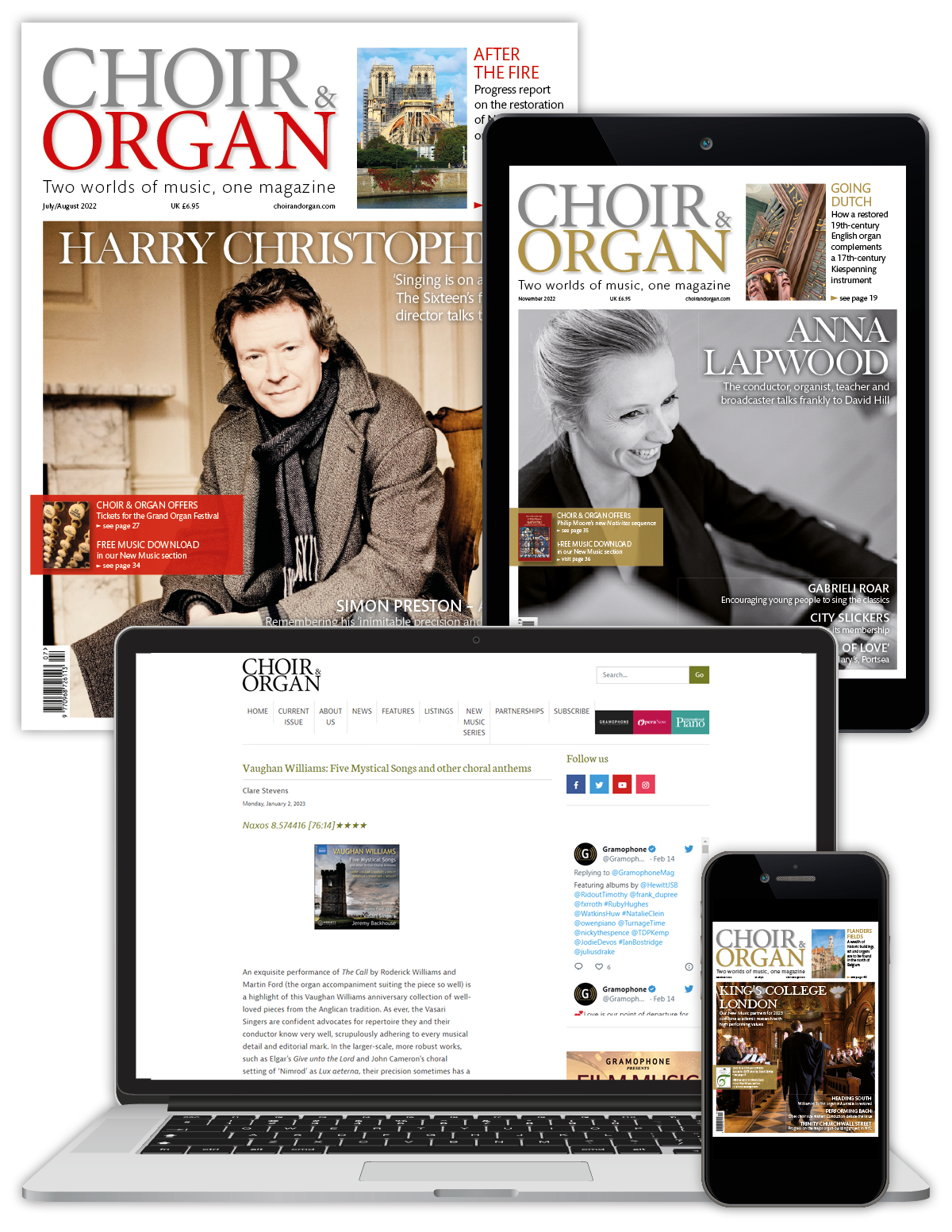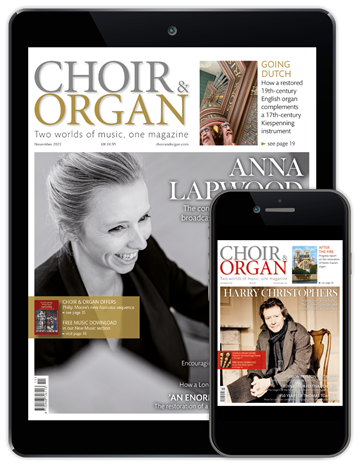Exploring Mander Organ Builders
Friday, November 8, 2024
Paul Hale visits the workshops of Mander Organ Builders, near Canterbury, where a variety of projects add to Britain’s organ-building heritage. Photos courtesy of the organ builder

Any organists working in Kent during the 1970s, ’80s (as I did) and on into the current century, would have been aware of two dominant organ-building companies in the area, which is covered by the Anglican Dioceses of Rochester in the north and Canterbury in the south. These two firms – N P Mander Ltd (later Mander Organs) and F H Browne & Sons – formed a sort of pincer movement: one coming down into the countryside from the East End of London, the other venturing north from Canterbury. F H Browne had been trading since 1871 (for the first 35 years in Deal) and over the next 100 years had built a large number of solid, reliable and well-voiced organs in Kent, initially with mechanical action, then with their own neat design of tubular-pneumatic action, eventually moving on to electro-pneumatic action. They maintained hundreds of organs, many of them their own, and were often selected to restore or rebuild them. N P Mander built few brand-new organs in Kent because there was little call for them by the time Noel Mander was fully established, but undertook some of the most significant rebuilds, notable among them Canterbury Cathedral, Rochester Cathedral, Tonbridge School Chapel (subsequently destroyed) and Ashford Parish Church. Their skill at restoration also won them numerous contracts for bringing back to life several of the many small Hill, Willis, Walker and Forster & Andrews instruments in the south-east. Choir & Organ published an article by the current writer about Mander Organs from its founding by Noel Mander in 1936 (C&O Mar/Apr 2021, pp 25-28) with a more detailed version (helpfully amended by John Mander) available to subscribers on the magazine’s website.

The amalgamation of organ-building firms is nothing new; a glance at the history of the craft demonstrates that throughout the centuries. In the early years of the 20th century there were two significant amalgamations: Henry Willis & Sons with Lewis & Co (in 1919), following Norman & Beard with the Hill firm (in 1916). During subsequent decades several large firms – notably Henry Willis & Sons and Rushworth & Dreaper – made something of a feature of taking over other companies, either on the retirement or death of the proprietor, or because the business was failing. This gave them large tuning rounds, a steady additional income and also the opportunity to pick up additional restoration or rebuilding contracts. The names of the ‘absorbed’ firms were often displayed in small type on the company’s headed paper – some of them firms of great significance such as the John Compton Organ Company, taken over by Rushworth & Dreaper in 1964. Only very occasionally did the names of two companies amalgamate – ‘William Hill & Sons and Norman & Beard’ was one; rather a mouthful and happily later changed to ‘Hill, Norman & Beard’. ‘Henry Willis & Sons and Lewis & Co’ was another, though the Willis firm dropped the Lewis name in 1925, ironically while the most Lewis-like of its major instruments (that in Westminster Cathedral) was being made and installed in stages (1922-32).
The latest amalgamation has been that of Mander Organs with F H Browne & Sons in 2020, the latter taking over the name, goodwill and some staff of the former. Unusually, the Browne name was dropped in favour of the Mander name (now ‘Mander Organ Builders’), and thus the firm, in a fine new set of workshops (planned before the merger) in the Kent countryside is fair set for a productive new era.
At the time of the acquisition of the Mander business, F H Browne were in the process of developing several high-profile projects, which have included the rebuilding of the organ at Wimborne Minster, the five-manual chapel organ of Christ’s Hospital School, Horsham and St James’, Sussex Gardens, Paddington. A new mechanical action organ was designed for St Mary’s Church, Reed and was completed during 2024. Work in hand also includes a new four-manual organ for St Paul’s Church, King Cross, Halifax. Let us examine four of these projects, starting with Wimborne Minster.
The Wimborne organ dates from 1664, when Robert Haywood, an organ builder based in Bath, erected a new instrument on the rood screen which then stood at the head of the nave. In 1764, Brice Seede carried out major work, as did George Pike England in 1812. Robson enlarged the Swell in 1844 and in 1856 removed the organ to the south choir aisle on the destruction of the screen. In 1867 it was completely rebuilt and modernised by J W Walker. The same firm carried out an electrification in 1965, adding a detached console, tonal additions along ‘Baroque-revival’ lines, with a Schwimmer-based wind system and an Orchestral Trumpet projecting from the west-facing ‘functional’ pipe front. After more than 50 years the organ was again in need of a complete overhaul, with attention being given to certain musical weaknesses of the 1965 scheme which had become apparent over the decades, as taste and usage changed.

The new instrument for Halifax, due for completion in 2025: reservoirs under construction
With guidance from Dr William McVicker, Mander Organ Builders carried out a complete rebuild. The Choir and Great soundboards are new, mounted in a revised layout on a new building frame, with seven new single-rise reservoirs. The electrical systems throughout are new, as are the swell engines for the west and east shutters now fitted to the Swell box. The Great is now cantilevered out of the west-facing arch, enhanced with a new case. Another new case stands in front of the north-facing side of the organ, speaking across the choir stalls. The tone of the Choir Organ emerges most clearly from this case. Tonal additions include a 32ft Subbass and a Tuba – to be used as an alternative or in combination with the 1965 ‘en chamade’ reed, which I’m pleased to say has been kept (after a period of doubt). The Choir has also gained a Violin Diapason and a Dulciana (the latter formerly on the Great), helping this division to function well as a small Great when accompanying the excellent minster choir. The 1965 console has been completely restored, with new electrics and elegant toe pistons instead of the trendy but awkward toe levers fitted in 1965. Given the notably dry acoustics of the minster and the challenge of a really difficult location, the success of this rebuild is commendable.
Next for the firm was its comprehensive work on the enormous V/72 Rushworth & Dreaper organ of 1931 in the spacious school chapel of Christ’s Hospital, Horsham. This organ was built for C S Lang when he was music master there, and his famous Tuba Tune was composed for the mighty Tuba at the west end of the chapel. The organ had been restored once in its life – by R&D in 1981 – and in recent years has been much in need of further work, especially as the famous west-end division was no longer functioning and multiple wind leaks in the main organ had left it scarcely playable. The soundboards were restored, with new underactions, no fewer than 13 new single-rise reservoirs being made, along with completely new wind trunking, new swell engines, a new pedalboard, an adjustable bench, and completely new electrical systems throughout (using fibre connectivity to the west end). The four Aston Webb cases were restored, as was the console, which was fitted with new stop knob solenoids, key contacts and pistons, the stop jamb panels also being replaced to allow for new combination system displays and other alterations. Tonal improvements were modest but significant: a new Twelfth, Fifteenth and Mixture IV on the Great, a new Mixture IV and Vox Humana on the Swell, and a new top octave to reinstate the former Octave Wood on the Pedal. Three other stops were revoiced for more brightness and the Solo’s 4ft Stopped Flute was transposed to 8ft as an atmospheric flute celeste.

The new instrument for Halifax, due for completion in 2025: computer imaging showing one of two cases
The Christ’s Hospital contract was carried out in 2023 and led swiftly on to a contract for a new organ of a completely different type. This has been built for the charming little countryside church of St Mary, Reed (Royston), and was opened by Hugh Morris (director of the Royal School of Church Music) on 22 June 2024. A two-manual, tracker-action organ, it has a reversed low-level console and uses four ranks of pipework from the previous organ plus selected ranks of vintage pipes, in addition to a new Sesquialtera and Great Open Diapason (19 of whose pipes are in the elegant oak case, three embossed). A necessarily compact organ, it therefore uses Schwimmers built into the soundboard wells.
The stop list is very much one that the Mander firm might have devised before the merger, one example being that of the two manual reeds, Trumpet on the Great and Oboe on the Swell (a choice about which, as a player, I have my doubts).
Strolling round the light and airy Mander workshops, one finds the wind system and slider soundboards of the next new organ being made – for St Paul’s Church, King Cross, Halifax. This is an extraordinary project, for the four-manual organ is based on a large body of 1904 Lewis & Co pipes from St Saviour’s, Croydon, which have been in store for more than 40 years. Many of us knew about these pipes, but few ever imagined that they would eventually find such a perfect home.
The instrument will be physically new, including two ‘gothic’ cases (the chancel case based on the 16ft Violon), and will incorporate 26 Lewis ranks (including a 32ft Contra Posaune), nine ranks from the previous St Paul’s organ, six new Mixtures and a new 32ft Contra Bourdon ‘polyphone’ bass. St Paul’s is a large and beautiful Gothic Revival building, designed by Sir Charles Nicholson, accommodating 1,000 people. There is an organ loft on the south side of the chancel, which contained until recently a 1912 Abbott & Smith which reused much of the former church’s 1883 Henry Halmshaw organ. It is good that the best of this pipework will remain in use. The new detached four-manual console will stand on the north side of the church, at the head of the nave.
Completion is planned for autumn 2025 and the specification is unusual enough to warrant appearing here.
Mander Organ Builders has certainly found itself once more in the mainstream of British organ building. Never has this been more important than now, when we are experiencing a dearth of companies large enough to take on such projects. They are to be congratulated.
One hundred and fifty years in business
When F H Browne & Sons was established in 1871, there was a great expansion in church building, not least among the Non-Conformists. The business quickly grew and in its first 35 years many organs were built for churches and chapels, in the UK and for destinations as diverse as Egypt and Canada. Several of F H Browne’s sons joined Frederick in the business which also included a general music shop selling sheet music, pianos, American organs and other musical instruments.
In 1906 the premises in Deal were sold and the company moved to Canterbury. By this time Frederick’s eldest son, William, was managing the business, with Frederick continuing to take an active part until his death in 1933. Sadly, William died six months after his father. The company continued to trade with assistance from various members of the family but largely through the efforts of Alfred Willey, who had joined the company as an apprentice prior to the First World War. It was he who ensured that the company continued to provide services during the Second World War.
After the war the company was reformed as F H Browne & Sons (Organ Builders) Ltd with Alfred Willey as managing director. He was joined by Harry Fagg, a long-standing employee of the company, and several members of staff took shares in the new company. This period saw a great expansion in the use of electric action and the development of organs using the extension principle. Willey and Fagg presided over a period of sound and steady activity, guiding the fortunes of the company together for over 35 years. Both died within a month of one another in 1982. Following this, a new partnership was established between Roger Greensted (who had joined the company as an apprentice in 1963), Reginald Cobb (another long-standing employee) and Gordon Chapman, a well-known local organist. In 1983 the company moved premises to The Old Cartwright School in Ash, near Sandwich, which itself was built in 1871, the same year in which F H Browne set up his original business.
After a long period of planning and design, in December 2019 the company relocated to a purpose-built and well equipped workshop at The Wilderness, Church Lane, West Stourmouth, the current location of its office and workshops. On 1 October 2020, ‘Mander Organ Builders’ was formed, incorporating F H Browne and some former Mander Organs staff, building on the combined expertise of these two well established organ builders. With more than 600 organs in its care, clients are spread across the UK and as far afield as the USA. Stephen Bayley has been managing director since 2013; having originally joined the firm as an apprentice, he gained wider organ-building experience in the UK and abroad with Mander Organs, before returning to F H Browne in 2008. The company is now run by Stephen Bayley, Yvette Bayley (company secretary) and Michael Keays (joined 2015, organist of Aylesford Parish Church).
Paul Hale has written extensively about organs while also working as a cathedral organist, teacher and organ consultant






